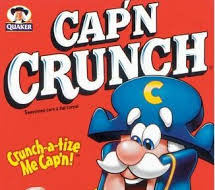Julie Eva Borowski has done it again with a solid video on the issue of libertarian in-flighting. The caricature has me saying something wonderful about the decision to pour milk in my cereal. “Beautiful anarchy!”
Well, it’s not entirely absurd. The decision to pour milk or not to pour milk is an illustration of human volition that is embodied in all our decisions. There is no police present at the moment of choice. There is no plan in place that makes us pour or not to pour. Even if there were a plan, it is likely to be ignored. It would be destined to fail.
Actually, as I think about it, there is something of a plan. According to the government, cereal is only part of a “nutritious breakfast.” You know, the pictures on the ads. There is a big glass of orange juice, a piece of toast with butter, probably another glass of milk, and probably a half slice of grapefruit. It’s absurd. I’ve never seen anyone eat all that on a regular basis with cereal. On the contrary, we shake the box in the bowl and eat. We are defying the plan, even that urged on us by manufacturers.
So yes, there is a core of anarchism in the decision to pour and eat.
And it doesn’t just stop with the pouring and eating. The anarchist dimension of production is illustrated in the very existence of milk and cereal.
Humankind lived 6,000 years without a reliable source for milk. Milk spoils. It must be transported before that happens. Before trains and refrigeration, you were pretty much out of luck, unless you owned a goat or cow, or someone close by did. We underestimate what a seminal moment it was in the history of civilization for milk to be delivered to your doorstep back in the 1930s and 1940s. It was wonderful practice and culturally significant commercial institution, displaced only with the mass spread of electric refrigeration in the 1950s. If you think about it, we are only a few generations into a period in which people could reliably keep things cold in all months of the year. Milk was and is a luxury good.
There was no plan. There was no government push. It happened because of private enterprise operating in the spirit of freedom: “people need stuff so let’s get it to them.”
Now to the source of milk itself. It comes from cows. Modern socialists hate cows because they seem implausibly inefficient. They eat vast amounts of grain and grass, take up huge swaths of land that could be used for farming, and otherwise consume an enormous amount of resources. To keep one alive just to milk is a big expense, one requiring the accumulation of capital and long-term planning.
Think of this: no central planner, a person who assumes that he or she knows better than the market, would ever approve of a cow. On the face of it, there would be no way to know for sure, in absence of market prices and a profit-and-loss system, that a cow should be allowed to live.
Now to the cereal question. The variety and brands have delighted generations. No one person can make a box of cereal. It takes thousands, with ingredients that can come from all over the world. But there is an additional point here worth considering. Many brands have been around for decades and generations. They persist and persist. It is a point of unity between us: we’ve all had Cheerios, Shredded Wheat, Sugar/Honey Smacks, Cap’n Crunch.
I was in the car the other day with some people I had not met and we were all fishing around for topics. Finally I brought up cereal, and the whole scene came to life. We talked and talked about the changes in Crunchberries, the shifts over the years in Lucky Charms, the yuckiness of puffed wheat, and much more. It was pure delight.
So within the cereal industry, we have authentic tradition at work. That’s an interesting observation about a market institution. Markets are said to be in constant upheaval and thereby always in a war against tradition. This is not actually the case. Cereal is a persistent tradition, even down to the original brand names. It has been done without any plans from government, any preservation boards and bureaus, or even hectoring traditionalists warning us against abandoning the permanent things.
We can therefore see how anarchism isn’t really about unrelenting unpredictability. Within cereal markets, we can see that anarchist-like production can preserve valuable traditions insofar as consumers — the real power behind the market — want it to be this way.
What the milk and cereal market needs is more anarchism, not less. Raw milk should be completely legal here as most everywhere else in the world. People should be allowed more choice. It is the same with the regulations and taxes that make entry into the cereal market more expensive than it ought to be. Let there be more brands, more producers, ever more choice.
And yet, let’s return to Julie’s original example of the decision to pour milk. In the end, it is ours and ours alone. There is no force of the state that can successfully enforce a single choice in this area. States aren’t that powerful and they never will be.
So, yes, let us eat cereal, pour milk, and consider the great lessons of this event. It really does illustrate a beautiful anarchy.














What a great article!
What a great article!
“So, yes, let us eat cereal, pour milk, and consider the great lessons of this event”
“So, yes, let us eat cereal, pour milk, and consider the great lessons of this event”